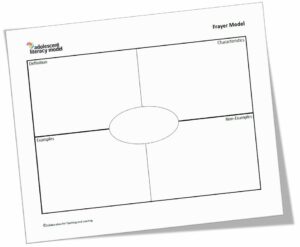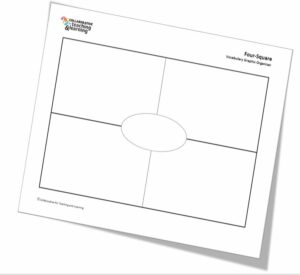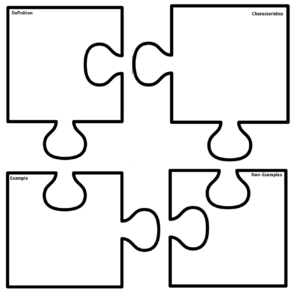STRATEGY FOCUS
Frayer Model & Four-Square Adaptation
PURPOSE
The Frayer Model is a graphic organizer that promotes critical thinking and helps deepen students’ understanding of key vocabulary. When using this strategy, students determine and clarify the meaning of targeted vocabulary words encountered while studying key concepts or big ideas. By providing students with a structure to examine these words, focused primarily on contextual meaning and not simply definition, this strategy is effective in helping students come to understand vocabulary at a level beyond defining words. The focus on characteristics, examples, and non-examples pushes learners to build a more concrete understanding of the meaning of the words.

PROCESS
- Pre-select key vocabulary word(s) from the text or the unit and review them with students.
- Provide students the Frayer Model graphic organizer and explain the four sections and what they mean. When introducing the Frayer Model, it is important to use a Think Aloud to model the process of how to use the Frayer Model with a vocabulary word.
- Work with the students to build knowledge of the term. You can use small group discussion, review various artifacts such as pictures, images, primary sources, charts, etc.
- Have students work together to identify examples and relevant non-examples.
- While monitoring student progress, share new ideas with the class to discuss and have students add characteristics as they are recognized. Work with students to identify those essential characteristics from the examples and non-examples compared to non-essential characteristics.
- Provide groups an opportunity for students to share their thinking with others through an Academic Dialogue strategy, posting artifacts around the room. Posting around the room allows students to revisit and extend thinking and reference for the remainder of the unit of study.
PROBING QUESTIONS
CONSIDERATIONS
- How was your understanding of the word(s) similar or different from someone else?
- What is your rationale for examples and non-examples?
- How did the Frayer model help you with learning new vocabulary?
- How might you encounter or use this word again?
- The Frayer Model is primarily used during, and after learning to deepen understanding.
- Preparing students to effectively use the Frayer Model should be a gradual release process that provides modeling and scaffolding. For example, the teacher may complete a Frayer Model with the whole class with accessible content before having students do them with a partner or small group.
- The Frayer Model is NOT intended to be used as a worksheet for homework.
- Consider pairing the Frayer Model with another Vocabulary strategy such as the Interactive Word Wall or an Academic Dialogue strategy, as discussion is an important part of this strategy.
Four-Square Vocabulary Graphic Organizers
While the Frayer Model includes four distinct categories for investigation (definition, examples, non-examples, and characteristics), Four-Square Vocabulary Organizers use alternative categories. This adaptation changes the level of thinking students are expected to use, but can be utilized to access new vocabulary supporting different disciplines and/or learners’ needs.

CONTENT APPLICATIONS
![]() MATHEMATICS (FOUR-SQUARE ADAPTATION)
MATHEMATICS (FOUR-SQUARE ADAPTATION)
Students studying a specific process in mathematics, and focusing on vocabulary about that process, may benefit from modifying the process to analyze the process using representation and questions rather than non-examples and characteristics.
![]()
HEALTH & PHYSICAL EDUCATION (FRAYER MODEL)
Students studying the benefits of physical activity on well-being would dive deeper into clarifying the differences between examples and non-examples of physical activity. This discussion may also help students think about the essential characteristics of the benefits versus the non-essential characteristics.
![]()
SOCIAL STUDIES (FRAYER MODEL)
Students studying Democratic Principles would spend time making sure they understand Democracy at a deeper level.
![]()
SCIENCE (FRAYER MODEL)
After investigating cells and body systems and developing their conceptual understanding, students co-construct definitions, examples, pictures and non-examples for key scientific terms based on their experiences/understanding.
![]()
WORLD LANGUAGES (FOUR-SQUARE ADAPTATION)
Students learning new vocabulary in the target language may benefit from adding visual representations of words as the example, as well as finding synonyms and antonyms in the target language instead of characteristics.
PDF Reproducible
Sources
Frayer, D., Frederick, W. C., and Klausmeier, H. J., (1969). A Schema for Testing the Level of Cognitive Mastery. Madison, WI: Wisconsin Center for Education Research.

